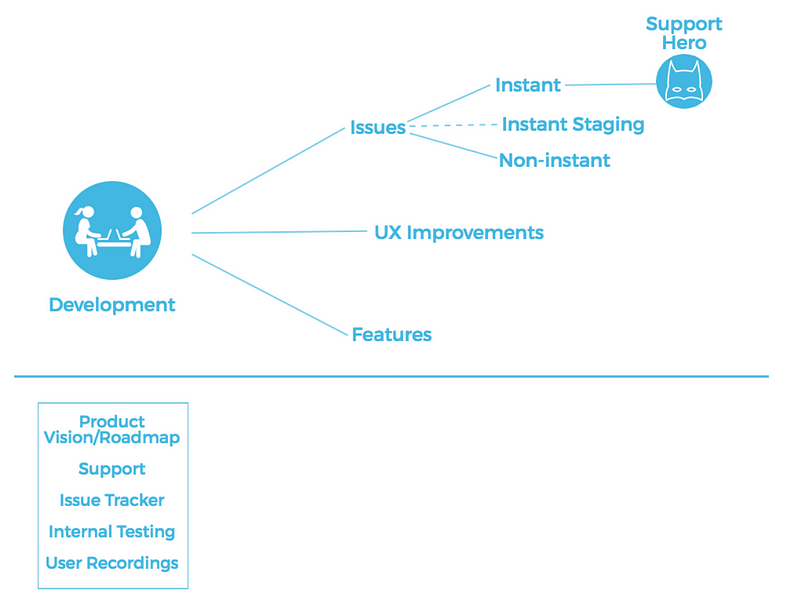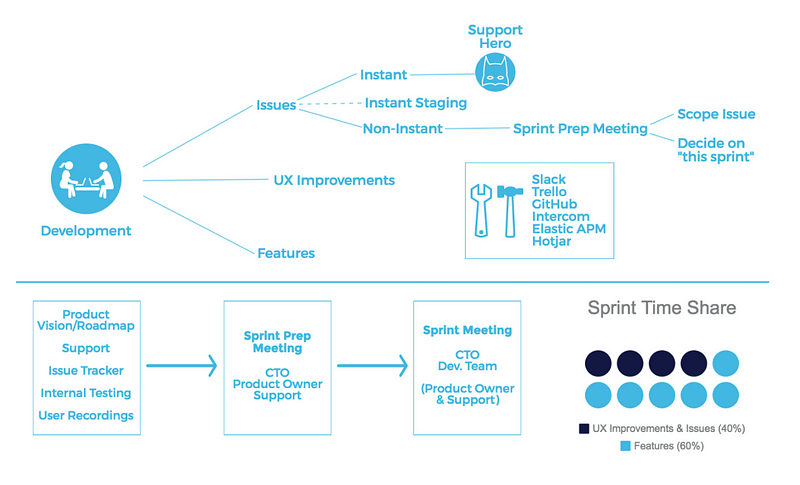Cómo organizar el desarrollo en una startup de software lean
Interior Salesflare
Crear una empresa tecnológica puede ser un proceso caótico, estresante y gratificante.
But one of the things that can really help early on is to have structures in place that empower your team to work effectively and efficiently — especially on the development side. The last thing your company needs is chaos around building your product. 😱
Entonces, ¿cómo empezar? ¿Y si contrata externamente o contrata internamente?
Below is a quick guide to building and structuring your SaaS development team — and if you do decide to outsource, you can use this guide as a framework as well. 🤩
Categorizing development at your company
One of the things that can help with development structure is to break down the different types of development tasks at the company into categories, so you can have a better idea of prioritization, delegation and organization within the team. 🤝
A continuación figuran las tres categorías de desarrollo que tenemos en Salesflare:
Cuestiones son cosas que no funcionan y que hay que arreglar en el producto.
But what has priority? And how do you organize them? That’s why we’ve broken issues down into three additional categories: instant issues, instant staging and non-instant issues.
Instant issues are the ones that — you guessed it — need to be addressed immediately. These can be things that are really broken, things that the users notice, things in the app that need to be fixed, etc. 🚨

Instant staging is not as “instant” as instant issues, but these are things that need to be fixed before releasing the newest software version into the production environment. These are mostly issues that we notice on our staging environment through internal testing.
Los problemas no instantáneos son de menor prioridad y se debaten en la reunión de preparación del sprint (más adelante hablaremos de ello).
Mejoras en la experiencia del usuario tienen mayor prioridad que los problemas no instantáneos e incluyen cualquier cosa en desarrollo que tenga que ver con la experiencia y la usabilidad del producto. Básicamente, se trata de cosas que mejoran la experiencia de los clientes.
Características son nuevas funcionalidades que queremos añadir al producto, como acciones masivas, filtrado avanzado, etc. Son las tareas menos prioritarias de las planificadas durante un sprint.
Aunque desglosar los tipos de desarrollo puede ayudarle a organizar mejor su equipo, ¿cómo decidir quién se ocupa de qué?

Support Hero is here to save the day!
As a SaaS company ourselves, we understand the importance of addressing issues promptly to give customers the best experience possible. However, that doesn’t mean that we should have the entire team spending their days jumping on issues — we’d never get any other work done! 👨💻👩💻
That’s why we use a system that both removes distractions and increases productivity within the development team. We call it the Support Hero.

The Support Hero is one person on the development team, rotated daily, that focuses on instant issues that need to be addressed (and answers more in-depth and technical questions users have), so that the team can stay focused on their tasks. 💪
Any issues that can’t be fixed in that exact moment by the Support Hero are logged in GitHub, the software we use for code and issue management, and is then addressed as soon as possible.
The beauty of having a Support Hero is that even with a small team, you can offer high-quality support to your customers — any in-depth technical issues can be fixed on the spot, avoiding the frustrating process of having to hand off issues to the “right” person.
La mejor parte: having a Support Hero brings your developers closer to your customers. 💛
It’s all about structure
Now that we’ve touched on the types of development and how to delegate issues, let’s discuss how to organize your structure. All of the different components below come together to inform how the team moves forward.
Una visión del producto y una hoja de ruta can help you know where you want to bring the product, so you can then have features in mind that will get you there — this ideally overlaps with what you pick up from your support. 👓
Ayuda es todo sobre las opiniones de los clientes. Esto incluye peticiones de funciones, problemas y mejoras de UX, que siguen la visión del producto y la hoja de ruta antes mencionadas. Regístrelas y llévelas a la reunión de preparación del sprint.
Un gestor de incidencias reports errors both on the back-end and the front-end. It also allows you to see what issues appear even without people telling you. One suggestion is Elastic APM — but there are many options out there.
Pruebas internas allows your whole team to test new features before they go live. We test actively before releasing updates from staging to production. And since we use Salesflare internally, we can therefore detect possible issues and improvements in the product ourselves as well. It’s always good to have your team use your product whenever possible to get first-hand exposure to any issues that can arise and to have a deep understanding of your own product.
Hotjar Las sesiones de grabación pueden ayudar a tu equipo a ver cómo interactúa la gente con el producto y dónde van las cosas mal (o bien). Las grabaciones de usuarios, aunque no son necesarias a diario, pueden ofrecerte información adicional sobre cómo utiliza la gente tu producto, ya que puedes ver lo que hacen sin necesidad de que te lo expliquen.

Time to sprint!
Structure your development team’s work into sprints — an agile methodology. As a general guideline, two-week-long sprints are most common for IT and software product development. 🏃
However, it’s recommended to prepare ahead of your sprint meetings — otherwise things can get a bit chaotic and off-topic.
This can be addressed by having sprint preparation meetings. The CTO, product owner, and product manager (read more about the difference between product owner vs product manager) attend this meeting, and use this time to look at instant issues that are remaining, UX improvements, non-instant issues, and features. This helps set the agenda and priorities for the upcoming sprint without needing to take time out of the sprint meeting itself. ✅
Then, of course, it’s time to have your sprint meeting! The sprint meeting zooms in technically on what was discussed during the sprint preparation meeting, so that the development team knows exactly how they will go about things. It also gives a platform to review instant issues together as a team. This meeting should include the CTO and development team. The product owner and support team can also join, but are less needed at this stage.
At the start of this meeting, it’s a good idea to reflect on the previous sprint — what went well, what went wrong, etc.

What’s in your toolkit?
The tools you use within your company can set your development team up for success. We’ve already touched on Hotjar and Elastic APM, but some other tools to consider for more streamlined communication and task management include:
Slack — para debates internos, actualizaciones/notificaciones, intercambio de archivos y algún que otro gif gracioso.
Trello — para tarea/gestión y seguimiento de proyectos quién hace qué en un sprint determinado
GitHub — donde registramos los problemas, las solicitudes de funciones, etc.
Intercom — para comunicarse con los clientes
A great aspect of using these tools is that they can interact with one another. For example, we get updates from Trello and Github in Slack. And in Trello we use a GitHub power-up that integrates GitHub info into Trello. 🌐
Además, podemos vincular GitHub a las conversaciones de Intercom, de modo que siempre tengamos el contexto a mano; y cuando lanzamos funciones o solucionamos problemas, podemos comunicarnos al respecto sin fallos.

Regardless of how you decide to structure development at your company, it’s always important to make sure that your team — no matter how big or small — can work within the processes you decide to utilize. 🚀
Don’t be afraid to change things if they aren’t working! The key is to find what works for you and your company and go with that.
Esperamos que esta guía rápida le haya servido de inspiración para crear y estructurar su equipo de desarrollo.
Have more great ideas? Tell us in the comments! ✨
¿Le ha gustado este artículo? Consulte el resto de nuestros Interior Salesflare serie.
Para más información sobre startups, marketing de crecimiento y ventas
- 22+ Los mejores podcasts de ventas que deberías ver en 2024 - 21 de diciembre de 2023
- Guiones de llamada en frío para seres humanos reales - 21 de septiembre de 2023
- Las más de 25 mejores herramientas de ventas para ayudar a tu equipo a tener éxito - agosto 10, 2023
